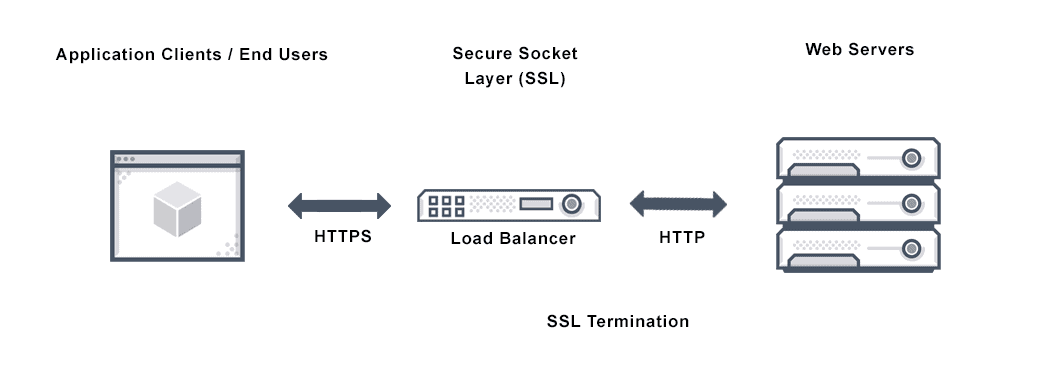SSL Termination Definition
SSL termination describes the transition process when data traffic becomes encrypted and unencrypted. This happens at the server end of a secure socket layer (SSL) connection.

What Is SSL Termination?
SSL termination is a process by which SSL-encrypted data traffic is decrypted (or offloaded). Servers with a secure socket layer (SSL) connection can simultaneously handle many connections or sessions. An SSL connection sends encrypted data between an end-user’s computer and web server by using a certificate for authentication. SSL termination helps speed the decryption process and reduces the processing burden on backend servers.
How Does SSL Termination Work?
SSL termination intercepts encrypted https traffic when a server receives data from a secure socket layer (SSL) connection in an SSL session. SSL termination or SSL offloading decrypts and verifies data on the load balancer instead of the application server. Spared of having to organize incoming connections, the server can prioritize on other tasks like loading web pages. This helps increase server speed. SSL termination represents the end — or termination point — of an SSL connection.
What is SSL Termination Load Balancer?
SSL termination at load balancer is desired because decryption is resource and CPU intensive. Putting the decryption burden on the load balancer enables the server to spend processing power on application tasks, which helps improve performance. It also simplifies the management of SSL certificates.
Is SSL Termination Secure?
Secure socket layer (SSL) connections are important for sensitive data. One point to note is that after SSL termination unencrypted traffic is sent between the load balancer and the backend server on the local area network. However, for security purposes, administrators can choose to re-encrypt the traffic at the load balancer before sending it to the servers.
SSL termination at load balancer alleviates web servers of the extra compute cycles needed to decrypt SSL traffic. The security risk of terminating at the load balancer is lessened when the load balancer is within the same data center as the web servers. Some load balancers also provide the ability to use a self-signed SSL between the load balancer and web servers. This provides a secure connection, but requires more compute power.
Can SSL Termination be Performed in Software?
With the advancement of Intel x86-based CPU technology, support for SSL on standard Intel hardware has increased dramatically. The use of Elliptic Curve Cryptography (ECC) keys with shorter key lengths than traditional RSA 2K keys for SSL encryption has put software based load balancers on x86 servers ahead in many cases.
An Advanced Encryption Standard New Instructions (AES-NI) is now integrated into many processors. The purpose of the instruction set is to improve the speed, as well as the resistance to side-channel attacks, of applications performing encryption and decryption the latest security standards. Another key reason to use software-based SSL termination is to completely decouple the dependence on hardware to a simple software version upgrade, and to get support for the latest security versions and bug fixes.
Does Avi Offer SSL Termination?
Using 100% software Avi as the endpoint for SSL enables it to deliver high performance in terms of SSL transactions per second (TPS), maintain full visibility into the traffic and also to apply advanced traffic steering, application security via WAF and acceleration features. Avi offers support for both RSA 2K as well as modern ECC keys for SSL. With the ability to scale a single virtual service horizontally (across multiple servers) as well as scale vertically on a single server (with more cores and higher processing power), Avi’s elastic load balancers support millions of SSL transactions per second and better scalability and price/performance benefits than hardware load balancers.
For more on the actual implementation of load balancing, security applications and web application firewalls check out our Application Delivery How-To Videos.
For more information on SSL termination see the following resources: